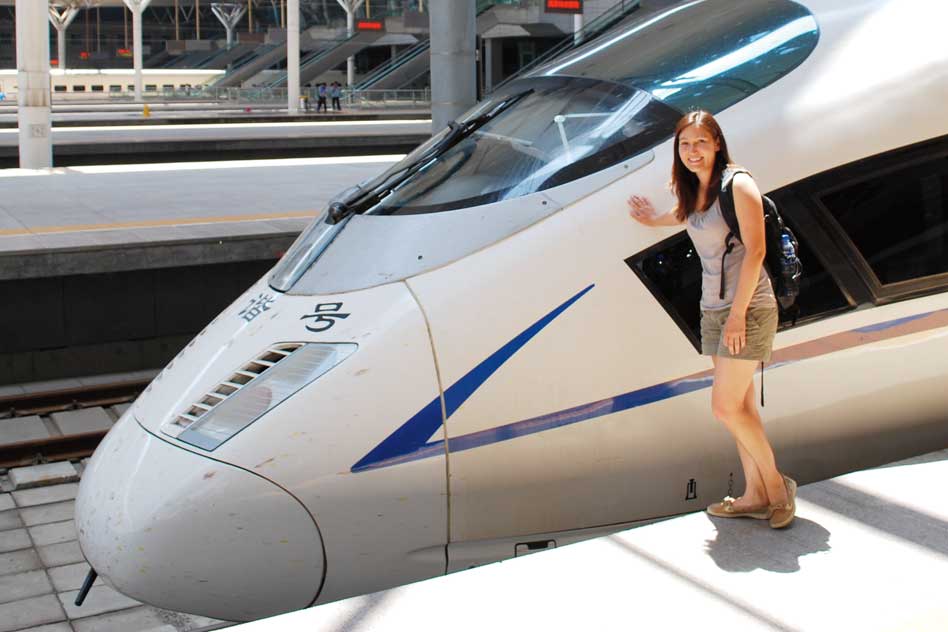
In fall 2010, the Jack C. Tang ’49 Fund provided funding to the Laboratory for Energy and the Environment for travel grants to be awarded to MIT graduate students working to promote environmentally sustainable practices in China. Among those supported in summer 2011 was Regina Clewlow, graduate student in the Engineering Systems Division, who traveled to Beijing to gather data on how Chinese commuters choose between high-speed rail and air for their intercity travel.
Interviewing commuters in Beijing’s summer swelter, Regina Clewlow was “won over” by the willingness of complete strangers to answer her detailed questions about air and high-speed rail. Her survey on the travel preferences of Chinese commuters provided essential data for Clewlow’s Engineering Systems Division dissertation on the links between transportation infrastructure and climate change. What happens in China, Clewlow suggests, has great import for the rest of the world. Global aviation accounts for 3% of greenhouse gas emissions and is growing steadily. Decisions made now by nations to accommodate expanded air travel will have significant implications for local air quality and global climate change for decades to come. Clewlow has been studying whether the introduction of lower-carbon alternatives such as high-speed rail (HSR) might curb an international appetite for air travel. While she had pursued this question in the United States and Europe, she was finally able to extend her investigations to China as a result of the Tang grant. The stakes are especially high in China, which experienced a 16% increase in air travel between 1978 and 2009, and where the population clamors for new and better routes between major cities.
Clewlow’s research, grounded in both econometrics and civil engineering, aims to understand how demands for transportation systems evolve. In China, she was most interested in learning whether environmental concerns have any impact on passengers’ selection of transportation, specifically between HSR and air travel. Clewlow arrived in Beijing at the beginning of June 2011 and set up camp at Tsingua University, where she developed her survey and posted ads on RenRen, China’s Facebook, to recruit a team of undergraduate helpers.
Before the trip, she read translated Chinese transportation studies, which mainly focused on “assessing people’s sensitivities to travel time and price,” she says. Clewlow’s survey aimed to assess the common factors that impact people’s travel decisions, including income level, education, profession, and reasons for traveling, as well as their attitudes toward the environment and safety.
In July, Clewlow set out with volunteers in Beijing, and another group went to work in Shanghai, to collar commuters at the cities’ HSR stations and airports. “Some people might have felt sorry for or intrigued by the American who was trying to collect surveys in poorly spoken Mandarin,” she says. In fact, Clewlow is proud that she communicated well enough to gather “quite a few surveys” on her own, and found “people surprisingly open to filling them out.” She speculates that many might have been happy to kill time with her survey since they were stuck for hours waiting at the airport or train station: “There can be a lot of uncertainty about how long it takes to get around in Beijing and Shanghai. Local traffic is often so bad you have to leave really, really early.”
One major hitch to the research: the devastating July 23, 2011, accident in Wenzhou, when two HSR trains collided, killing 40 and injuring hundreds. Infused with billions of government dollars in the previous decade, China’s HSR program had been touted as a reliable and reasonably priced alternative to air travel. Now, it appeared to have grown too fast, with construction tainted by possible shortcuts and shoddy safeguards. While China immediately slowed down the maximum speeds for HSR lines (from a blazing fast 385 kilometers per hour to 350 or less) and launched investigations, commuter confidence was nonetheless seriously shaken. Clewlow realized that her questions and analysis of the tradeoffs commuters make among safety, cost, and environmental concerns would have to take this event into consideration.
Although she is only partly through digesting the data from 550 surveys, Clewlow believes her Chinese travelers in general show a greater preference for HSR. Clewlow also finds that “although there were encouraging results related to environmental issues and their influence on traveler choice,” commuters weighed reliability and safety heavily into their decisions. Whatever the final results, Clewlow’s China research will play a pivotal part in a larger examination of international policy and investment in transportation infrastructure, an analysis she hopes “will help policymakers make educated decisions.”
This article appears in the Spring 2012 issue of Energy Futures.